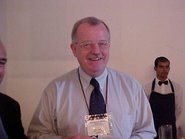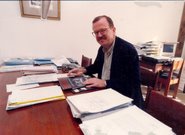



 Denise Hamú and Susana Calvo, Working with the Environmental Conventions, other IUCN Commissions and the UN Decade for ESD
Denise Hamú and Susana Calvo, Working with the Environmental Conventions, other IUCN Commissions and the UN Decade for ESDIt was also during this time that CEC demonstrated leadership in the area of Education for Sustainable Development (ESD). Daniella Tilbury was the first Thematic Chair for ESD and coordinated a range of initiatives which build international momentum in this area. IUCN CEC featured in major international dialogues leading to the World Summit on Sustainable Development held in Johannesburg in 2002. CEC members mobilized support for the proposal to establish a UN Decade in Education for Sustainable Development. This energy resulted in UNESCO and other international organizations recognizing CEC as one of the most important ‘portals’ to the worldwide community of experts in ESD and environmental education and communication.
By the time the Decade proposal was finally endorsed by the UN General Assembly in 2003, CEC members were already engaged in activities to help practitioners make sense of ESD in practice and develop processes to support the Decade. CEC was successful in extending the ESD discourse beyond schooling to embrace informal learning, advocacy and communication activities. It recognized that most conservation and environmental decisions were taken by adults who needed support and opportunities to learn about sustainable development. Through its profile CEC was invited to sit at the table with other intergovernmental actors as they worked to affect policy at different levels. Like in previous post Tiblisi events CEC members were invited to shape the Tiblisi+30 conference through its steering committee and had an active role in a variety of workshops. Since the turn of the century CEC members, among others Marco Encalada, Ana Puyol and Marta Andelman were also key leaders in the Environmental Citizenship Project in Latin America, a project in partnership with UNEP and UNESCO.


 Daniella Tilbury; Ana Puyol; Marta Andelman.
Daniella Tilbury; Ana Puyol; Marta Andelman.The turn of the century witnessed the global introduction of the second generation of interactive web utility, moving past static information-based web pages. CEC capitalized on this new technology through its existing members, and through an initiative to build a new sub-constituency within its membership of educators based in higher education institutions and universities. The World Conservation Learning Network was launched through this growing internal group, using new interactive online learning opportunities available globally for learning and professional updating. CEC experimented with a new interactive portal tailored to the needs of the users and equipped with tools for on line surveys and other knowledge management features. These examples which were soon followed by other parts of IUCN. In the same way training expertise, demand articulation skills, survey expertise, facilitation capacities and meeting management skills showcased by CEC were increasingly making their way into IUCN programs.


 Launch of the World Conservation Learning Network Bangkok, 2004; On-line course on Environmental Flow; CEC Portal.
Launch of the World Conservation Learning Network Bangkok, 2004; On-line course on Environmental Flow; CEC Portal.By the mid-2000’s and the wealth of knowledge that lies at each individual’s fingertips, attention has turned again to communication and learning, and their role in the behavior change needed for societies to use the information and knowledge available for action. The current CEC Chair Keith Wheeler (USA, 1952) is taking the development of CEC to the next level by focusing on change processes and the realization that facilitating partnerships is vital to cope with change. From mid 2005 the Commission is supported by a secretariat headed by Gillian Martin-Mehers.


 Keith Wheeler, Gillian Martin-Mehers, International Workshop Exploring Deep Change Processes, 2006.
Keith Wheeler, Gillian Martin-Mehers, International Workshop Exploring Deep Change Processes, 2006.At this point in time learning, knowledge management and communication are the major knowledge areas of CEC. In the fast-paced, dynamic environment in which IUCN and other actors in the conservation and sustainability community find themselves, CEC positions itself as the knowledge network for creating strategic communication platforms, leveraging new learning for professional development and facilitating the co-creation of sustainable solutions. The focus is on new interactive technologies, the next phase and operationalisation of the World Conservation Learning Network; and on dialogue and consensus-building processes that help stakeholders move past knowledge to action. CEC continues to evolve responding to the changing world, the strengths that its Chairs, Governance Committees and Members bring, seeking to contribute to the work of IUCN as it works towards achieving its vision: “A just world that values and conserves nature.”









No comments:
Post a Comment